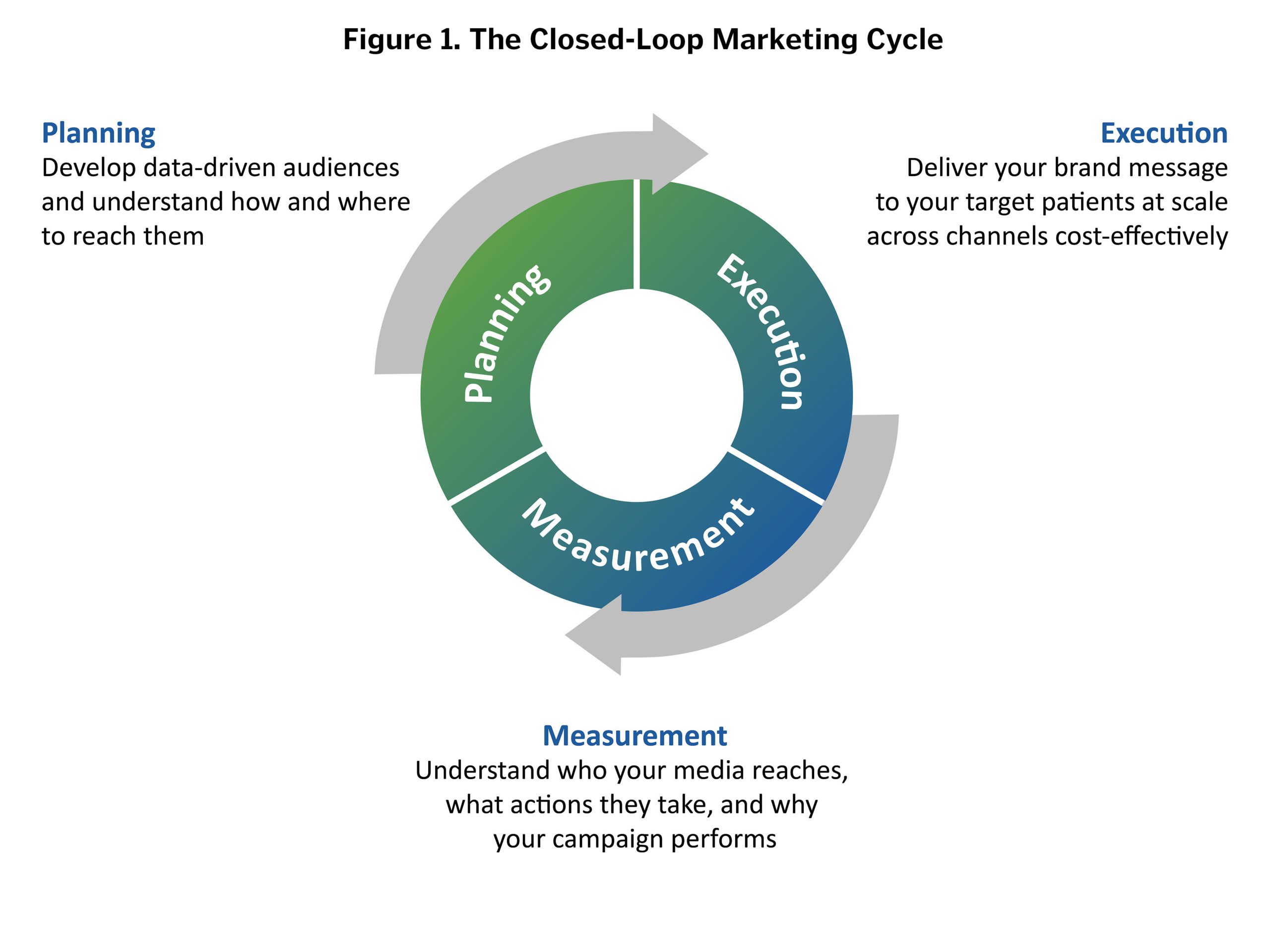Are you spending your marketing dollars as efficiently as you can? Are you confident your patient segmentation is used all the way through to campaign execution and measurement? Can you effectively reach your target patients with your marketing plans? Finally, are you able to truly understand your campaign, from the initial segmentation to the channel execution, to maximize your return on investment (ROI)? The answer we receive from many pharma marketers for all of these questions is typically “No.”
Hearing this feedback made us revisit Closed-Loop Marketing, a concept that’s been around for a long time, and can mean different things to different people. We define it as the ability to use consistent data assets (this is key!) from planning to execution to measurement, and gaining insights for developing a new, more impactful plan to restart the cycle (see Figure 1).
 The results of using consistent data assets are manifold: greater trust in the data; smooth campaign execution; and importantly, strong confidence that outcomes are based on the audience and the marketing actions, rather than by different data sources throughout the process. To best understand the implications for the entire closed-loop cycle, we will take you through each step along the process from planning to execution to measurement.
The results of using consistent data assets are manifold: greater trust in the data; smooth campaign execution; and importantly, strong confidence that outcomes are based on the audience and the marketing actions, rather than by different data sources throughout the process. To best understand the implications for the entire closed-loop cycle, we will take you through each step along the process from planning to execution to measurement.
Planning
As a pharma marketer, you need to understand the target patients who are indicated for your product. Various methods are at your disposal to accomplish this, including literature reviews, primary market research, and claims-based analyses like patient journeys. Once you identify your patient segments, the next step is to profile them so you can develop your marketing plan.
You can gain insights that drive creative development, such as lifestyle attributes, psychographics, attitudes, and behaviors. You can also develop a media plan by understanding your targets’ channel preferences and engagement. For example, by understanding which digital channels your patients spend time on, or how they consume television, you’ll be prepared to serve your brand message appropriately.
A robust data-driven approach will ensure you develop a strong plan. The data assets used should be representative of your patient population and have robust preference insights to inform your plan. However, a plan cannot just sit on a shelf; you must leverage the segments and insights in your campaign, and then measure your actual effectiveness in reaching the planned targets.
Execution and Targeting
As mentioned, marketing plans should include the media channels your target patients spend time consuming and then be prioritized based on budget and patient engagement with each channel. These can include television (linear and advanced data-driven TV); digital (programmatic, endemic, search); social; email; and even more traditional vehicles such as direct mail. Where possible, conduct A/B testing to maximize the value of your investments in real-time and focus on better-performing components.
Also, make sure each media vendor understands your patient segments. Challenge them to serve ads to those segments as precisely as possible. Media partners should help you reach your target patients, at scale, cost effectively by delivering strong audience quality and conversion to your brand. Each should also provide recommendations on reach, frequency, and engagement level. As you work with each vendor, develop strong key performance indicators (KPIs) to assess the performance of each channel and that of the campaign overall.
Campaign Impact Measurement
Having a strong measurement platform is critical to understanding how your campaign performs, your ROI, and importantly, how to refine your original plan and maximize the yield on your marketing spend. It’s important for your measurement system to combine early response metrics, such as online impressions and clicks, with subsequent offline metrics based on actual exposed patient health behaviors.
These offline metrics measure audience quality based on pre-exposure diagnoses and treatments, as well as post-exposure specialist visitation, and ultimately net conversion to your brand and ROI. We believe the offline metrics are the gold standard because they help ensure you reach your targets and get a favorable impact. In addition, optimizations based on offline metric impact will, by design, drive incremental prescriptions in the future.
Your measurement partner should articulate which channels perform best, while being transparent in describing data sources and analysis methodologies. Furthermore, analytics suppliers must deliver insights relevant to your original segment planning and media choices, and recommend data-driven optimizations. Your measurement platform should be “always on” with exportable results for powering your marketing decisions over time, in a continual closed-loop cycle.
Conclusion
Your marketing investment is critical to the success of your brand and is increasingly under scrutiny. It’s essential these valuable resources are deployed in the most cost-effective way to maximize the product and portfolio growth.
Many pharma clients tell us they begrudgingly use multiple analytics data sets: one for segmentation and planning, another for audience targeting and campaign execution, and yet another for campaign impact measurement. But by using consistent data assets, you’ll have greater confidence that results are driven by the segmentation, campaign execution, and measurement, rather than noisy variations across data. Leveraging the familiar concept of closed-loop marketing with innovative data and technology can provide you that assurance.










